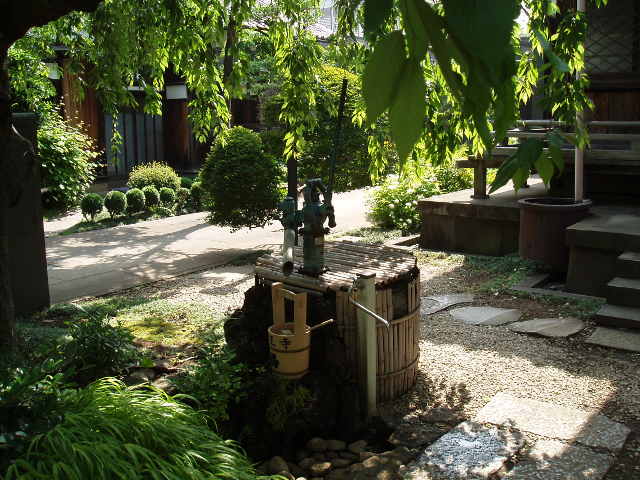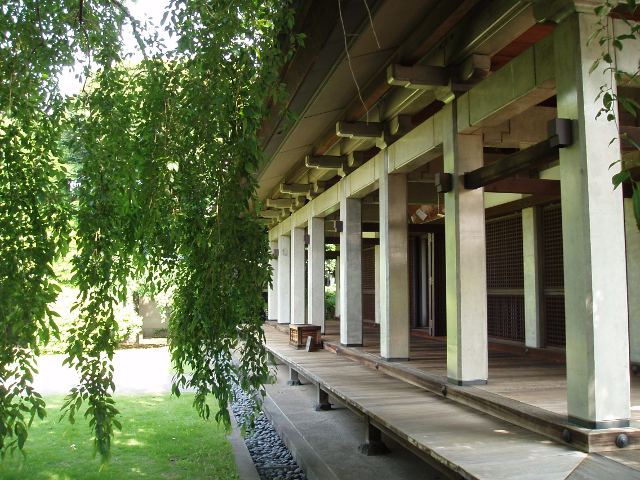Tennouji-Temple in Yanaka
There is a small temple named “Tennouji” at the top of “Momijisaka-Stop” near the south exit of JR Nippori station.
The temple is located within around 8 minutes walking distance of my residence. We can feel and enjoy the passage of the seasons in the temple garden.
Vicissitudes of temple
The Tennouji Temple has a long history and is far older than Kan-Eiji Temple which is a family temple of Tokugawa Shogunate.
They were established by one of devout believers in Nichiren sect of Buddhism in 1274. It’s the oldest among around 70 temples currently located on Ueno Hill.
At the height of their prosperity, they were possessing the most of current Yanaka cemetery. And they were also the owner of 5 story-pagoda which
was burned down because of lovers’ suicide in 1958.
There used to be a big temple complex.
In the history of 740 years, they were persecuted by Tokugawa Shogunate
who believed in Tendai sect of Buddhism. Then they were forced to convert
to Tendai sect from Nichiren and to rename Tennouji from Kannouji
Temple.
During Boshin Civil War, Tokugawa royalists stationed a guard
at the temple. As a result they were embroiled in the skirmish between Tokugawa and Imperial royalists. Sward scars vividly remain on the column of the old building. These make us to understand that the temple has survived after passing through difficult and distressing situation.


Snatching a soothing moment in small and compact garden
In contrast to their cruel history, their garden is offering us soothing and calming as one does not think that it is located near railway system in the center of big city.
Whenever I visit this temple, I make it rule to sit on Nure-En or wooden narrow deck being protruded from the floor of prayer’s hall where the principal image, Amida Nyorai (Amitabha Tathagata in Sanskrit) is being worshipped. The god is said to lead us to the land of happiness.
Then, upon looking around the garden, I can view a cherry tree with weeping branches in front of an old well on the side of tiny prayer’s hall where god of “Bisyamonnten” in Japanese (vaizravaNa in Sanskrit) is being enshrined as war god.
In spring beautiful pink colored flowers bloom on the weeping branches being picturesquely harmonized with the old well and the prayers’ hall. It’s really tasteful scenery.
In the late spring a Sal-tree produces tiny flowers with white petals and yellow filaments. I can faintly scent the sweet fragrant being carried on gentle breeze. This tree is said to be present beside Buddha when he expired The flower of Sal-tree is also described in the opening lines of the Tale of the Taira clan (Japanese classical literature named Heike Monogatari) to proclaim that all glories must fade away.
In early summer Evergreen Mongolia near main gate is beginning to blossom huge white flowers with about 20-30cm in diameter. Each petal shapes like an oval saucer.
The floral language is said to be promising prospects. It makes me feel somehow encouraged.
And on the side of the Evergreen Mongolia the appearance of Great Buddha can be observed from behind. It is sitting to posture on a stone pedestal. It is a bronze statue with the height of about 4.8 M being covered with color verdigris.
It is said that the statue was casted in Genroku Era 326 years ago.
Since then the Great Buddha has been keeping an eye on the history of the Tennouji Temple.
In the late autumn foliage of Japanese maple tree turns impressive crimson. It tells us the approaching of winter time.
This temple is not appearing aloof and inaccessible but is open to visitors.
It is offering a bamboo bench at the center of the garden. We can put ourselves in a tranquil silence even though it is located amidst hustle and bustle of mega city of Tokyo.
Here is a place of healing indeed.
